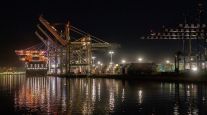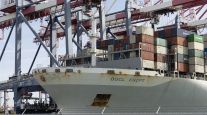Bloomberg News
Container Shipping Seeing Major Cuts After $364 Billion Boom
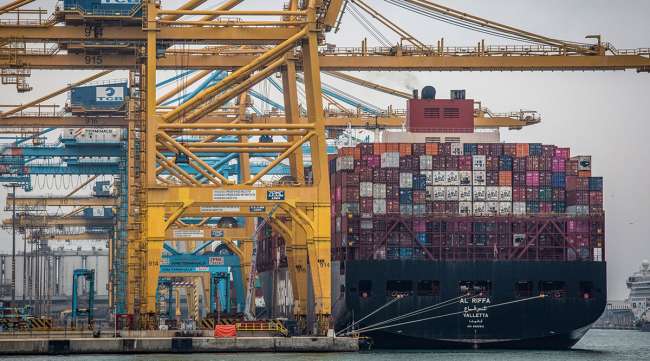
[Stay on top of transportation news: Get TTNews in your inbox.]
Consumers gearing up to buy the latest imported appliances, clothes or electronic gadgets this holiday season might want to spare a thought for the companies that will struggle to make money for the next few years hauling products across the ocean.
That’s because the container shipping industry, cast as the Grinch that spoiled Christmas over the past two years with record-high freight rates and slow deliveries, is returning to its pre-pandemic place in the corporate world: perennial underachiever Charlie Brown.
The biggest carriers posted net income totaling $364 billion in 2021 and 2022, according to figures compiled by industry veteran John McCown, after a decade of scant profits. They’ll likely drift back into the red this quarter as the rates they charge fall below costs and look to stay there for the foreseeable future.
Booms-turned-busts have been more abrupt and sensational, but rarely has an established industry so tied to the global economy lurched from historic profits to below break-even levels more directly than the shipping lines that move 80% of the world’s merchandise trade have this year. After COVID-19’s massive demand shock, the culprit now is too much supply.
“I’m certainly concerned about the next 24 to 36 months,” Rolf Habben Jansen, CEO of Hamburg-based Hapag-Lloyd AG, said in an interview in November. “We are going to see a downturn.”
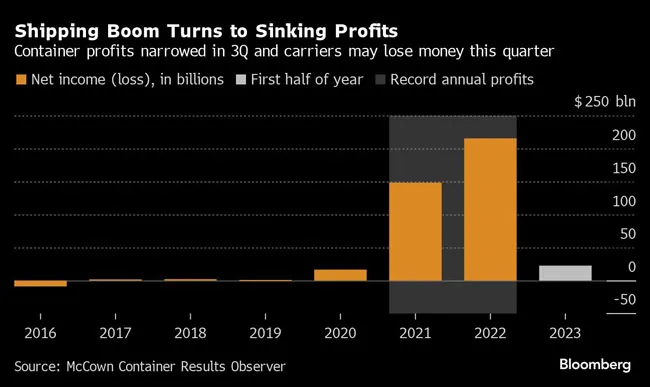
Consider the tougher times facing A.P. Moller-Maersk A/S, the largest publicly traded container line. According to Bloomberg Intelligence credit analyst Stephane Kovatchev, the Copenhagen-based company’s free cash flow, which reached $27 billion last year, may drop about 80% this year and could turn negative in 2024. That may weigh on the company’s bonds, he wrote in a research note on Nov. 10.
Over the past 10 days, Maersk, Hapag-Lloyd and closely held CMA CGM SA of France — all top-five players that together control about one-third of the world’s container capacity — said they’re cutting costs as some fear the slump will last at least through 2024.
Some executives are urging against price wars, which contributed to a wave of consolidation and at least one major bankruptcy in the years leading up to the pandemic.
“Each actor will have to be responsible to ensure that the market remains reasonable amid rates that are relatively low,” CMA CGM Chief Financial Officer Ramon Fernandez told reporters Nov. 10. “Price wars after a while hurt not only those who start them but everyone.”
Such concern stems from a combination of economic forces: Goods demand is returning to pre-pandemic levels just as supply is rising in the form of new, bigger ships. It can take two to three years to build a containership, which typically operate for about 25 years. So timing their launch and retirement with the ebbs and flows of the business cycle is inherently difficult.
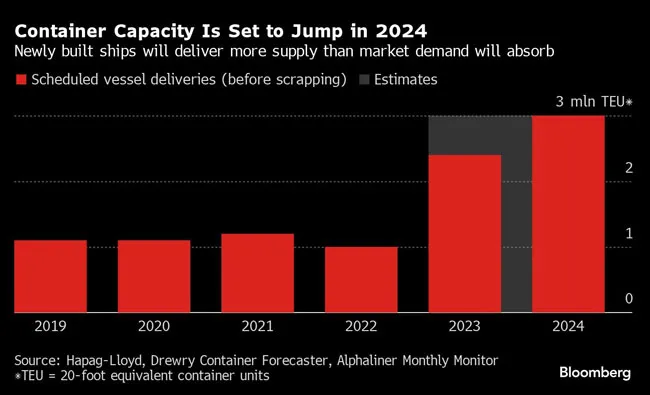
To manage capacity in the short term, the main tools at the carriers’ disposal are canceling individual voyages or suspending services entirely on trade lanes where demand is weak. In prolonged slumps they can also let charter contracts expire, idle some ships or sell old ones in the scrap steel market.
Kovatchev said what’s emerging is a standoff between the strong and the weak. “The bigger companies such as Maersk and Hapag-Lloyd have the cash to wait and focus on cost-cutting, as opposed to aggressive capacity reductions — for now,” he said. “It all boils down to supply, demand and who will blink first.”
Of course, the flip side of shipping’s pain are lower costs for the manufacturers and retailers that own the cargo being transported, which ultimately helps central bankers tasked with bringing down still-elevated inflation across many developed economies.
“A couple years ago, it was double-digit inflation in goods prices and maybe a 4% or 5% increase in services,” said Phil Levy, chief economist at Flexport Inc., a San Francisco-based digital freight-forwarding company. “To the extent you were getting inflationary pressure from goods, or in a very tight goods market — that has disappeared.”
Companies including clothing brand Under Armour Inc. and furniture maker Lovesac Co. cited relief from lower ocean shipping expenses over the past quarter.
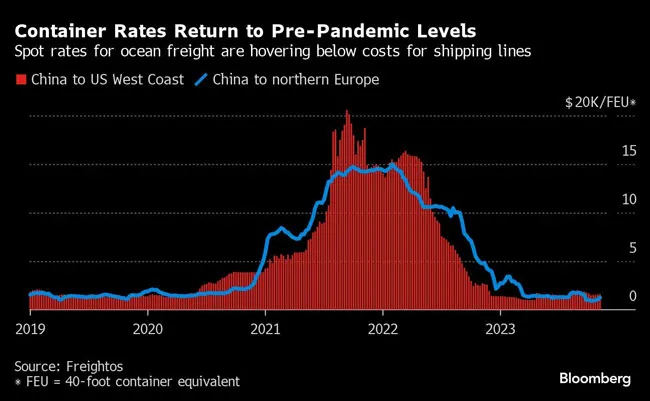
With inflation eating away at their paychecks, consumers are being cautious about spending and seeking cheaper ways to have parcels delivered.
“Our own data tells us that the wider economic picture may be having an influence on the services our customers opt for, with many looking for more cost-effective shipping options,” said Karen Reddington, president of FedEx Express Europe. “We expect external business conditions to be challenging in the near term, and there remains uncertainty with respect to the timing of demand recovery.”
For the container carriers, the cost of moving merchandise can’t stay this low indefinitely, because their expenses are heading in the opposite direction.
Transiting the Suez Canal from Asia next year, for instance, will be 15% costlier, the waterway’s authority said in mid-October without explanation. On the other main trade route, ships passing through the drought-stricken Panama Canal are facing long waits, surcharges and time- and fuel-consuming detours around South America to avoid the delays.
Those costs are small compared with the $1 trillion in investment the industry faces in the coming decades to decarbonize — a shift that will require engines that run on cleaner-burning fuels and new infrastructure to produce, store and transport the alternative fuels.
The big European carriers have issued estimates for the surcharges that’ll take effect with shipping’s upcoming entry into the European Union’s Emissions Trading System in January.
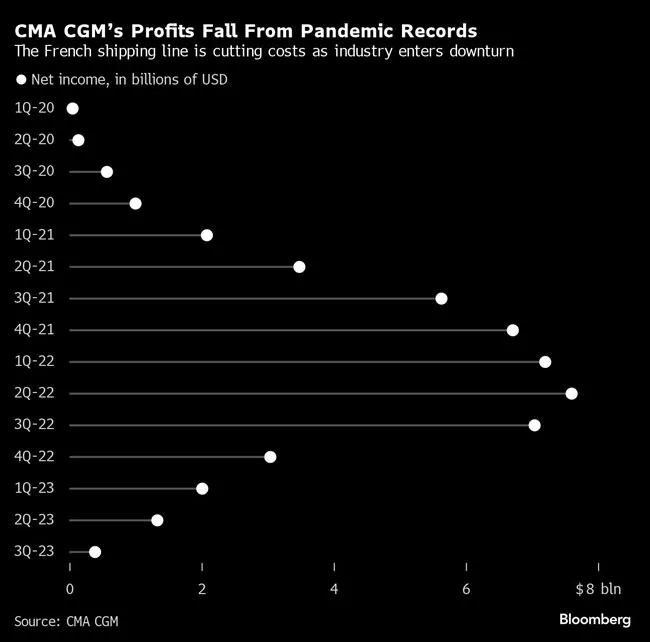
At CMA CGM, one of the strategies to cushion the peaks and valleys of shipping is to diversify. The second-generation scion Rodolphe Saade, who leads the company started by his father, has used the pandemic windfall to invest in an airline, ports and logistics operations and even the media.
The Saade family is worth about $19 billion, according to the Bloomberg Billionaires Index. That compares with $33 billion in April.
Maersk, CMA CGM and Hapag-Lloyd rank Nos. 5, 7 and 13, respectively, on the Transport Topics Top 100 list of the largest global freight companies.
Want more news? Listen to today's daily briefing below or go here for more info:


